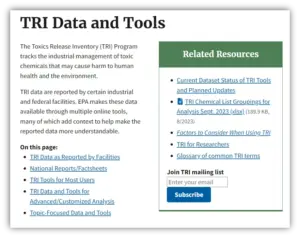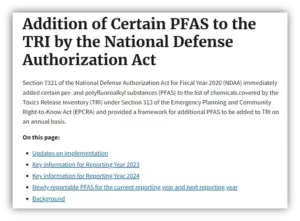The July 1 deadline for Toxic Release Inventory (TRI)/Form R reporting is quickly approaching. This year, an additional challenge that many EHS professionals may not know about is that EPA added additional per- and polyfluoroalkyl substances (PFAS) to the list of TRI reportable chemicals. You need to know whether you have TRI-listed PFAS in your inventory, and how much of them you used to determine if you need to complete and submit TRI reports for those chemicals. You’ll also need to understand how to keep up with requirements as EPA adds new PFAS chemicals to the TRI list in subsequent years.
In what follows, we’ll dive deeper into the addition of these PFAS chemicals to the TRI list, summarize what it means for you, and provide takeaways about chemical management and strategies for remaining in compliance with regulatory requirements.
What is the Background of TRI Reporting?
Section 313 of the Emergency Planning and Community Right to Know Act (EPCRA) establishes the obligation for certain facilities to prepare and submit a Toxic Release Inventory (TRI) Report, aka a Form R report, if their usage of TRI-listed chemicals exceeded applicable thresholds. Like other aspects of EPCRA, including Tier II reporting, EPA intends for TRI reporting to improve availability of information about the types and quantities of hazardous chemicals stored and used in facilities, to improve the effectiveness and safety of emergency response activities in the event of a spill or chemical release. At the time EPCRA passed, governments and communities around the world saw the need for better information about hazardous chemicals following the catastrophic release of deadly methyl isocyanate (MIC) gas at a Union Carbide facility in Bhopal, India in late 1984. Poor accessibility of information about the chemical and its hazards contributed to the severity of the accident, resulting in many thousands of deaths and hundreds of thousands of injuries and illnesses.
EPA makes information submitted by TRI reporting facilities publicly available via a variety of methods so users, including researchers and first responders, can obtain details about hazardous chemicals used in or near specific communities.

Not all facilities that store and use hazardous chemicals need to complete and submit TRI reports. You first need to determine if your six-digit NAICS code is subject to the requirement by consulting the most current list. Then, you determine if your facility had ten (10) or more full-time equivalent (FTE) employees during the reporting year, and finally, you determine if you manufactured, processed, or otherwise used an amount of a TRI-reportable chemical that exceeded the reporting threshold during the reporting year. You’ll need to complete and submit reports if your facility meets all three applicability criteria.
For most TRI-listed chemicals, the applicability thresholds are:
- 25,000 pounds for chemicals manufactured during the reporting year;
- 25,000 pounds for chemicals processed during the reporting year, including chemicals used in processes to manufacture other chemicals, and chemicals repackaged for distribution in commerce; and
- 10,000 pounds for chemicals “otherwise used,” a category that includes most uses not classified as either manufactured or processed, including chemicals used as cleanup solvents or as catalysts.
However, some categories of chemicals have lower thresholds, including persistent, bioaccumulative and toxic (PBT) chemicals such as lead, mercury, polycyclic aromatic hydrocarbons (PAHs), hexabromocyclododecane (HBCD), and dioxins and dioxin-like compounds have significantly lower thresholds. If you have chemicals with lower thresholds, you have an even more urgent need to know whether you have these chemicals in your inventory, and whether your usage in any reporting year exceeds the TRI applicability thresholds for those chemicals.
If you exceed thresholds for any TRI-reportable chemicals within a reporting year, you need to prepare and submit TRI reports for all applicable chemicals using EPA’s TRI-ME software, accessible via EPA’s Central Data Exchange (CDX). The deadline for TRI reports is July 1 each year for the previous calendar year’s data.
It’s also important to remember that EPA regularly updates its list of TRI-reportable chemicals, so you’ll always need to make sure you have the most recent list.
Why is EPA Adding More PFAS to the TRI List?
Speaking of updates to the TRI list, EPA has been adding new PFAS to the list annually for years now. Here’s the background you need to know.
PFAS are a broad class of synthetic chemicals that chemical manufacturers have produced in significant quantities since the 1940s. Historically, they have often been present in products such as firefighting foams, food packaging, and cooking ware.
While PFAS are still in use today, many companies are reducing their usage due to a growing number of studies indicating linkages between exposure to PFAS and various health effects, including reproductive and developmental defects, liver and kidney damage, and development of tumors. Concern over the use of PFAS has increased due to recent instances of significant PFAS contamination, such as a 25-square mile swath in Western Michigan impacted from decades of nearby manufacturing activities. Evidence of the risks PFAS pose to human health and the environment, and their persistence due to resistance to decomposition, have earned PFAS the label “forever chemicals” and resulted in increasing public concern and attention from regulators.
In the US, EPA is undertaking a “whole agency” response to the risks of PFAS, as described on the agency’s PFAS landing page. EPA’s actions include proposed rules to require management of specific PFAS as hazardous waste, monitoring PFAS in drinking water systems, and finalizing a significant new use rule (SNUR) preventing companies from starting or resuming the manufacture or processing of 329 PFAS that have not been made or used for many years without a complete EPA review and risk determination.
The US government also is addressing PFAS through the National Defense Authorization Act (NDAA), which is an annual bill that Congress uses to set guidelines for defense policy, as well as a range of issues managed by agencies outside of the Defense Department. Section 7321 of the NDAA for Fiscal Year 2020, signed into law on December 20, 2019, immediately added 160 specific PFAS to EPA’s list of TRI-reportable chemicals.

Earlier, you learned that the reporting thresholds for most chemicals are 10,000 pounds (for otherwise used) or 25,000 pounds (for manufactured or processed), but that some chemicals have much lower thresholds, including all PFAS on the TRI list to date. All PFAS that EPA has added to the TRI list have a reporting threshold of only 100 pounds, whether manufactured, processed, or otherwise used. Therefore, significantly lower quantities of these chemicals will trigger TRI reporting requirements—underscoring the need for establishments to ensure accurate tracking of inventory, throughput, and environmental releases.
The NDAA also includes a mechanism to automatically add new PFAS to the TRI list following certain EPA actions. For example, Section 7321(c) states that whenever EPA finalizes a toxicity value for a PFAS, that PFAS will be added to the TRI list on January 1 of the following calendar year. We’ve already been through several cycles of new PFAS added to the list of TRI chemicals, all of them with the 100-pound reporting threshold.
And that brings us right up to the present.
Which PFAS is EPA Adding to the TRI List?
The NDAA has continued to add new PFAS to the TRI list each year since 2020. For Reporting Year 2023 (TRI reports due by July 1, 2024), the NDAA added nine additional PFAS to the TRI list, bringing the total number of reportable PFAS to 189 for this reporting season. This means that if you manufactured, processed, or otherwise used any of these PFAS over the course of 2023, you’ll need to determine if the total amount used exceeded the 100-lb reporting threshold, and prepare Form R reports for those PFAS that exceeded the reporting threshold.
For Reporting Year 2024 (TRI reports due by July 1, 2025), the NDAA automatically added seven additional PFAS to the TRI list. Facilities in TRI-covered industry sectors should begin tracking and collecting data on these chemicals during 2024, for potential inclusion on TRI reports submitted in 2025 if usages exceed the 100-lb reporting threshold over the course of 2024.
The chart below summarizes the PFAS added to the TRI list for the 2023 and 2024 reporting years, and the dates that reports will be due, if applicable.
| PFAS | CAS # | First Reporting Year | Reports Due (if applicable) |
| Perfluorobutanoic acid | 375-22-4 | 2023 | July 1, 2024 |
| Sodium perfluorobutanoate | 2218-54-4 | 2023 | July 1, 2024 |
| Potassium heptafluorobutanoate | 2966-54-3 | 2023 | July 1, 2024 |
| Ammonium perfluorobutanoate | 10495-86-0 | 2023 | July 1, 2024 |
| Perfluorobutanoate | 45048-62-2 | 2023 | July 1, 2024 |
| Alcohols, C8-16, γ-ω-perfluoro, reaction products with 1,6-diisocyanatohexane, glycidol and stearyl alc. | 2728655-42-1 | 2023 | July 1, 2024 |
| Acetamide, N-(2-aminoethyl)-, 2-[(γ-ω-perfluoro-C4-20-alkyl)thio] derivs., polymers with N1,N1-dimethyl-1,3-propanediamine, epichlorohydrin and ethylenediamine, oxidized | 2742684-36-4 | 2023 | July 1, 2024 |
| Acetic acid, 2-[(γ-ω-perfluoro-C4-20-alkyl)thio] derivs., 2-hydroxypropyl esters | 2744262-09-5 | 2023 | July 1, 2024 |
| Perfluorohexanoic acid | 307-24-4 | 2024 | July 1, 2025 |
| Perfluoropropanoic acid | 422-64-0 | 2024 | July 1, 2025 |
| Sodium perfluorohexanoate | 2923-26-4 | 2024 | July 1, 2025 |
| Ammonium perfluorohexanoate | 21615-47-4 | 2024 | July 1, 2025 |
| 1,1,1-Trifluoro-N-[(trifluoromethyl)sulfonyl] methanesulfonamide | 82113-65-3 | 2024 | July 1, 2025 |
| Lithium bis[(trifluoromethyl)sulfonyl azanide | 90076-65-6 | 2024 | July 1, 2025 |
| Betaines, dimethyl(.gamma.-.omega.-perfluoro-.gamma.-hydro-C8-18-alkyl) | 2816091-53-7 | 2024 | July 1, 2025 |
Also, be sure you’re familiar with the full list of TRI-reportable PFAS. For that matter, it’s always a good idea to make sure you have the most recent list of all TRI-reportable chemicals.
EPA has compiled existing TRI reporting guidance to address frequently asked questions related to PFAS reporting and gathered links to external technical guidance.
What are the Takeaways on PFAS for EHS Professionals?
As you can see, the list of TRI-reportable chemicals continues to grow as EPA adds new PFAS. How can you be sure you’re doing what you need to do to keep up with TRI reporting requirements?
Here are key takeaways for EHS professionals.
You Need an Up-to-Date Safety Data Sheet (SDS) Library
SDSs are a primary source of information about the hazardous chemicals in your inventory, including composition, physical characteristics, safe handling procedures, and symptoms of exposure. For this season, having an up-to-date SDS library is a prerequisite for maintaining Form R compliance. The challenge has historically been that physical SDSs are difficult to access, especially when you’re not physically present at a facility, or when you have responsibility for multiple facilities.
Chemical management software makes it much easier to maintain an up-to-date SDS library, and to access your SDS from anywhere using mobile devices. If you have responsibility for multiple facilities, you’ll benefit even more from the ability to quickly pull up one of your operating locations from an organizational tree and review their chemical inventory, or conversely, to search for a specific chemical and identify all the locations currently using it.
Chemical Ingredient Indexing Can Help
One of the challenges of TRI reporting has always been difficulty knowing your chemical inventory at the ingredient level, so you can know whether chemical products you use contain TRI-reportable ingredients. Product names often have names like “Topcoat B” that offer few clues about what’s in them, which means you need to put in the work to manually review each SDS and somehow flag the chemicals on regulatory lists like EPA’s growing list of TRI-reportable chemicals.
Chemical management software helps here by making it easy to see individual ingredients within your products. The software then provides information about ingredient levels of concern (LOCs), which is a kind of hazard snapshot summarizing key information such as the regulatory lists that the ingredient appears on, including EPA’s up-to-date TRI list. You’ll have the information you need at a glance to know if you have TRI-reportable ingredients hidden in your chemical inventory—a benefit that’s more important than ever as the TRI list continues to grow.
Let VelocityEHS Help!
Having the right tools in place will go a long way to help you maintain compliance with current and future TRI reporting requirements for PFAS. VelocityEHS’ Chemical Management software offers easy management of your chemical inventory and SDS library, with the capability of providing 24/7 access to SDSs for your entire workforce.
Sophisticated ingredient indexing features make your chemical inventory visible right down to the ingredient level. Combined with a regulatory flagging feature, the indexing capability gives you a useful summary of relevant information including the ingredient level of concern and regulatory lists that the ingredient appears on. You’ll be able to quickly identify whether you use TRI-listed PFAS in your establishment, and track whether usages exceed reporting thresholds.
To learn more about how VelocityEHS can help you with TRI reporting and other areas of chemical regulatory compliance, including OSHA’s HazCom Standard and EPA Tier II reporting, schedule a demo with us today!
